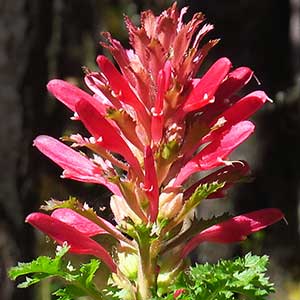Pedicularis densiflora
Pedicularis capitata
Indian warrior, warrior's plume
capitate lousewort, pédiculaire capitée
basal 1–10, blade lanceolate, 30–200 x 20–70 mm, 2(or 3)-pinnatifid, margins of adjacent lobes nonoverlapping or extensively overlapping distally, 1-serrate, surfaces glabrous, hispid, or downy;
cauline 4–20, blade lanceolate, 15–250 x 5–100 mm, 2-pinnatifid, margins of adjacent lobes nonoverlapping or extensively overlapping distally, serrate, surfaces glabrous, hispid, or downy.
basal 2 or 3, blade ovate or elliptic, 10–40 x 5–20 mm, 2(or 3)-pinnatifid, margins of adjacent lobes nonoverlapping or extensively overlapping distally, serrate, surfaces glabrous or hirsute;
cauline 0–2, blade elliptic, 5–25 x 5–10 mm, 2-pinnatifid, margins of adjacent lobes nonoverlapping or extensively overlapping distally, serrate, surfaces scattered hispid.
simple, 1–5, exceeding basal leaves, each 10–50-flowered;
bracts lanceolate to trullate, 10–35 x 3–5 mm, undivided or 1-pinnatifid, proximal margins entire, distal 1- or 2-serrate, surfaces glabrous.
simple, capitate, 1 or 2, exceeding basal leaves, each 2–8-flowered;
bracts subulate to narrowly lanceolate, 10–20(–50) x 6–8 mm, undivided proximally, undivided or 1- or 2-pinnatifid distally, proximal margins entire, distal serrate, surfaces sparsely tomentose.
2–4 mm.
2–3 mm.
calyx 9–18 mm, downy to tomentose, lobes 5, triangular, 3–4 mm, apex entire, ciliate;
corolla 23–43 mm, tube dark red, purple, or orange-yellow, rarely white, 8–18 mm;
galea dark red, purple, or orange-yellow, rarely white, 15–25 mm, beakless, margins entire medially and distally, apex straight;
abaxial lip dark red, purple, or orange-yellow, rarely white, 8–15 mm.
calyx 10–15 mm, hirsute, lobes 5, triangular to spatulate, 4–6 mm, apex serrate, glabrous;
corolla 19–40 mm, tube light yellow, sometimes cream to pink, 5–20 mm;
galea light yellow, sometimes cream to pink, apically sometimes diffuse purple, 12–20 mm, beakless, margins entire medially and distally, apex arching beyond abaxial lip;
abaxial lip light yellow, sometimes cream to pink, 10–15 mm.
= 16.
= 16 (Asia).
Pedicularis densiflora
Pedicularis capitata
Scarlet corollas with an undomed, toothless galea and two- or three-pinnatifid leaves are diagnostic of Pedicularis densiflora. This species occurs in forested subalpine regions of southern Oregon, western slopes of the Sierra Nevada, and the Coast Ranges of California south to Baja California. Herbarium records indicate northern populations of P. densiflora occur at higher elevations than do more southern populations.
(Discussion copyrighted by Flora of North America; reprinted with permission.)
Inflorescences of Pedicularis capitata display no more than five clustered flowers; the long, vertical corolla tube and curved galea that arches over the appressed, broad lobes of the abaxial lip are distinctive. The tip of the galea can be the same color as the corolla tube and abaxial lip but sometimes is a diffuse pink to purple and not distinctly bicolored as in the galeas of P. flammea or P. oederi, with which it is often confused.
(Discussion copyrighted by Flora of North America; reprinted with permission.)


